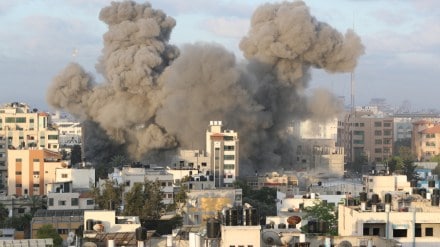In recent events that transpired in the Gaza region, the Israeli Defence Forces (IDF) have employed Thermobaric bombs, a devastating and controversial weaponry previously unused on civilians. These weapons have resulted in 4th degree burns and caused significant harm to those unfortunate enough to be within their blast radius. The usage of Thermobaric bombs has raised significant concerns due to their heightened destructive power compared to conventional explosives of similar size, inflicting severe consequences on those caught in their wake.
About Thermobaric bombs
Thermobaric bombs, also known as vacuum or aerosol bombs, or fuel-air explosives, consist of a fuel container housing two separate explosive charges. They can be deployed as rockets or dropped from aircraft as bombs. When they impact their target, the first explosive charge disperses the fuel mixture widely as a cloud, capable of infiltrating any building openings or defences that are not hermetically sealed.
Subsequently, a second charge ignites the cloud, resulting in a massive fireball, a formidable blast wave, and the creation of a vacuum that absorbs all surrounding oxygen. This weapon has the capacity to demolish reinforced buildings, destroy equipment, and cause harm or casualties to people within its range.
Thermobaric bombs come in various sizes, including those designed for individual soldiers, such as grenades and hand-held rocket launchers. Enormous air-launched versions have been developed specifically to target defenders hiding in caves and tunnel complexes, where their effects are most severe within confined spaces.
History
Notably, in 2003, the United States tested a 9,800-kilogram bomb dubbed the “Mother of all bombs.” Four years later, Russia introduced a similar device known as the “Father of all bombs,” unleashing an explosion equivalent to a 44-tonne conventional bomb, establishing it as the largest non-nuclear explosive device globally. Due to their overwhelming impact and effectiveness against fortified defenders in urban settings, Thermobaric bombs have predominantly found use in such environments.
What does the International Law say?
While there are no international laws expressly prohibiting the use of Thermobaric bombs, deploying them to target civilian populations in densely populated areas, educational institutions, or medical facilities may lead to allegations of war crimes under the Hague Conventions of 1899 and 1907. International humanitarian laws and the Geneva Conventions of 1949 require adherence to the principles of necessity and proportionality during conflicts.
Have these been used before?
Yes. The history of Thermobaric munitions dates back to World War II, with their initial use by the German army. Nevertheless, widespread development only occurred in the 1960s when the United States employed them during the Vietnam War.
Has the US used these ever?
Yes. The US used Thermobaric bombs in Afghanistan, first in 2001 in an attempt to eliminate al-Qaeda forces concealed in the Tora Bora mountains and later in 2017 against Islamic State forces.
What about Russia?
In 1999, Russia used them during its war in Chechnya, drawing condemnation from Human Rights Watch. Furthermore, Russian-made Thermobaric weapons were reportedly utilized in the Syrian civil war by the regime of Bashar al-Assad.
Russia-Ukraine War?
The controversy surrounding these weapons continues to persist, as Ukraine’s ambassador to the United States, Oksana Markarova, accused Russia of deploying Thermobaric weapons in its invasion of Ukraine. Publicly available information corroborates these claims, as the UK’s Ministry of Defence (MOD) revealed that Russia employed Thermobaric weapons, also known as vacuum bombs, in Ukraine. The MoD reported that Russia acknowledged using the TOS-1A weapon system, which employs thermobaric rockets, creating incendiary and blast effects. The Russian military refers to these units as “heavy flamethrowers” capable of launching rockets up to 9 kilometers.
Meanwhile …
Euro-Med Monitor’s team in Gaza reported Israel’s apparent use of Thermobaric weaponry, specifically vacuum bombs, in its offensive, resulting in far-reaching devastation and the ability to level multi-story structures. Additionally, unverified testimonies suggest that the Israeli army deployed tightly controlled white phosphorus munitions in the southern Gaza Strip.
The gravity of the situation in Gaza is underscored by initial estimates, indicating that over 40,000 families have been displaced from various regions of the Gaza Strip, fleeing the relentless attacks. The United Nations Relief and Works Agency for Palestine Refugees (UNRWA) reported that approximately 74,000 people sought refuge in 64 of its schools and shelters within the Gaza Strip. In a distressing turn of events, Israel even conducted an airstrike on a UNRWA school housing more than 225 individuals under the pretext of an underground tunnel.
According to an Israeli army spokesperson, the Israeli Air Force has dropped over a thousand tons of bombs on Gaza since the commencement of the assault. Israeli naval forces also participated in the bombing of areas near the Gaza coast. While Israeli forces issued “warnings” through phone calls, text messages, or by tapping roofs with drone missiles of limited destructive power, these efforts are insufficient to protect Palestinian civilians and do not absolve Israel of responsibility for the substantial number of civilian casualties.
Mass killings and the entombing of residents beneath the rubble of their homes exemplify Israeli bombing policies that disregard the principles of necessity and proportionality. Euro-Med Monitor has decried these actions as a form of retaliation and collective punishment, deliberately targeting civilian infrastructure to inflict widespread casualties and destruction. Such actions contravene international humanitarian law and the Geneva Conventions of 1949, constituting war crimes under the Rome Statute of the International Criminal Court.
